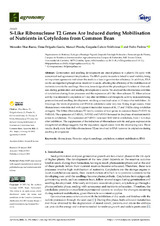S-Like Ribonuclease T2 Genes Are Induced during Mobilisation of Nutrients in Cotyledons from Common Bean
Autor
Díaz-Baena, Mercedes
Delgado-García, Elena
Pineda Priego, Manuel
Gálvez Valdivieso, G.
Piedras Montilla, Pedro
Editor
MDPIFecha
2021Materia
RibonucleasePhaseolus vulgaris
Seedlings
Cotyledons
Nutrient mobilisation
RNA
METS:
Mostrar el registro METSPREMIS:
Mostrar el registro PREMISMetadatos
Mostrar el registro completo del ítemResumen
Germination and seedling development are crucial phases in a plant’s life cycle with economical and agronomical implications. The RNA quality in seeds is linked to seed viability, being an important agronomic trait since this leads to a loss in germination efficiency. In addition, RNA can be an important phosphorous reservoir in seeds, affecting the efficiency of the mobilisation of nutrients towards the seedlings. However, knowledge about the physiological function of ribonucleases during germination and seedling development is scarce. We analysed the ribonuclease activities of cotyledons during these processes and the expression of S-like ribonucleases T2. Ribonuclease activity was detected in cotyledons at 1 day after imbibition and the specific activity increased during germination and seedling development, reaching a maximal value at 10 days after imbibition. At this stage, the levels of proteins and RNA in cotyledons were very low. Using in-gel assays, three ribonucleases were detected with apparent molecular masses of 16, 17 and 19 kDa along cotyledon ontogeny. The S-like ribonucleases T2 family consists of four genes in common bean (PvRNS1 to PvRNS4). The expression of PvRNS1, PvRNS2 and PvRNS4 increased in the phase of nutrient mobilisation in cotyledons. The expression of PvRNS1 increased 1000 fold in cotyledons, from 1 to 6 days after imbibition. The suppression of the induction of ribonuclease activity and gene expression in decapitated seedlings suggests that the regulatory signal comes from the developing axes. These results clearly state that S-like ribonucleases T2 are involved in RNA turnover in cotyledons during seedling development.

